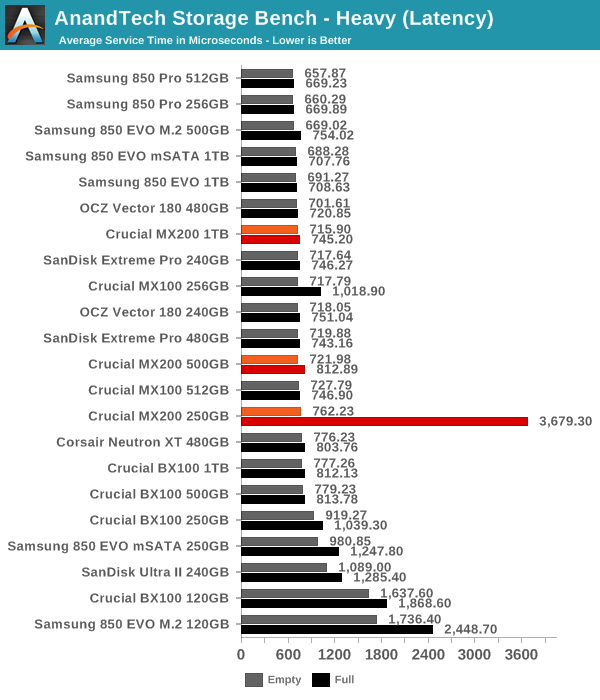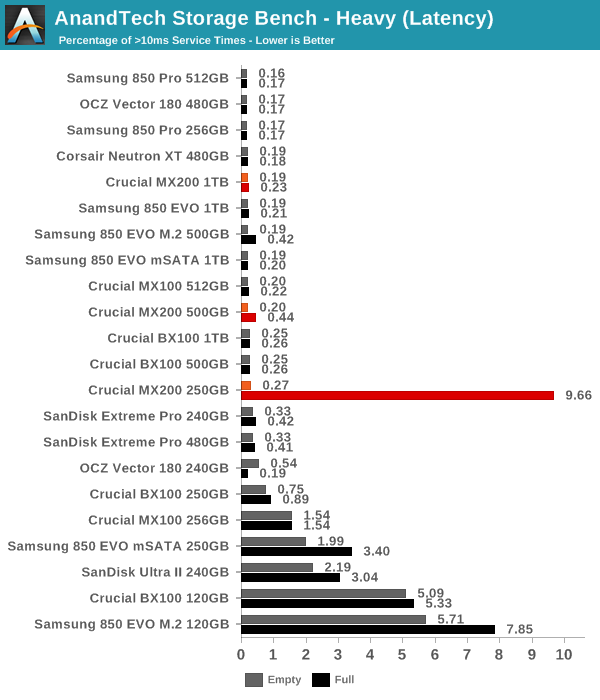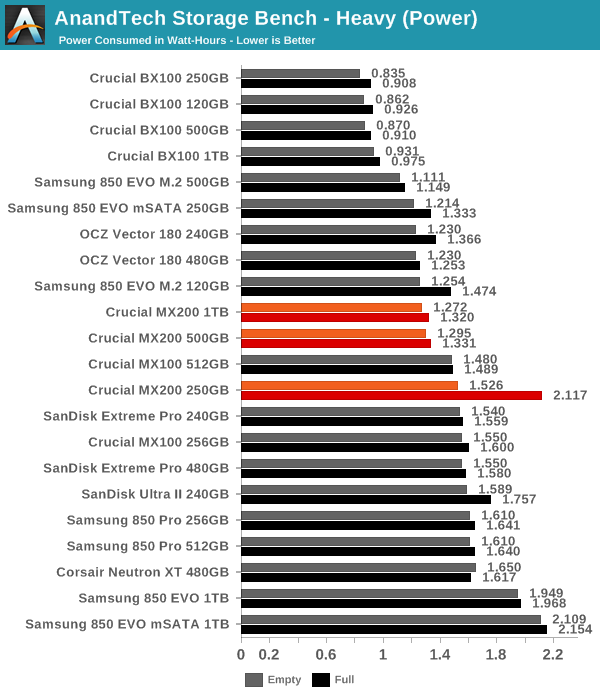Crucial MX200 (250GB, 500GB & 1TB) SSD Review
by Kristian Vättö on May 22, 2015 8:00 AM EST- Posted in
- Storage
- SSDs
- Crucial
- MX200
- Micron 16nm
AnandTech Storage Bench - Heavy
While The Destroyer focuses on sustained and worst-case performance by hammering the drive with nearly 1TB worth of writes, the Heavy trace provides a more typical enthusiast and power user workload. By writing less to the drive, the Heavy trace doesn't drive the SSD into steady-state and thus the trace gives us a good idea of peak performance combined with some basic garbage collection routines. For full details of the test, please refer to the this article.

In our Heavy trace the MX200 is an average drive: it's not as fast as Samsung drives, but roughly on par with the BX100. The most notable data point is the 250GB MX200 in full state because the drop in performance is tremendous, which is due to Dynamic Write Acceleration that is only enabled on the 250GB model. Because DWA writes everything to the SLC cache first, the drive constantly needs to migrate data from SLC to MLC, adding a significant amount of overhead and reducing the performance of host IOs.

The latencies are also good, except for the full 250GB MX200.

Power consumption under load is decent, but not BX100 level. The advantage over Samsung drives is notable, though, so the MX200 appears to be a pretty good fit for a laptop.











62 Comments
View All Comments
KAlmquist - Saturday, May 23, 2015 - link
I'm hoping that once other companies get 3D NAND into production we will see some interesting competition for Samsung.austinsguitar - Friday, May 22, 2015 - link
I love how they post this but not the mx100 tests.... whats the FKING POINT in testing than?Ryan Smith - Friday, May 22, 2015 - link
I'm not sure I follow. The MX100 is in our graphs.earl colby pottinger - Friday, May 22, 2015 - link
Question about the hardware encryption.Where does the key come from? Can I set my own key?
The reason I ask is, if all the drives have the same key from the manufacturer then it is like there is no key at all. As if you know one key you know them all.
If it is made by a random number generator, how do we not know there is a pattern from the generator so a hacker only needs to do a few thousand (million?) tests to break the encryption?
If on the other-hand we can set the key, is it easy to do? Is the key such that we can write it to the drive but it is hard to read out?
Vinchent - Friday, May 22, 2015 - link
Wow I just purchased the MX200 250GB a couple of days ago.If I had read this article before, I wouldn't have bought it.
btw, thanks for this great article, AT :)
RandUser - Saturday, May 23, 2015 - link
Lol, same for me here. Should have gotten a BX100. The MX200 performs without problems though, so no point returning it, just it's not the best value for money.MrSpadge - Saturday, May 23, 2015 - link
If you don't fill it in a sudden rush, it's still a fine drive. Not the best choice, but not terrible either.PaulBags - Friday, May 22, 2015 - link
The Samsung 850 pro 1tb is missing from most charts, disappointing.Sejong - Friday, May 22, 2015 - link
No comments on the NAND being 16nm? Is this not an issue? I am reluctant to buy MX100, 200 and BX100 when there is M500 still in stock (the price seems to be rising).Another review request : Intel`s new SSD 535 (this seems to use hynix 16nm NAND memory).
MrSpadge - Saturday, May 23, 2015 - link
No, it's not an issue. Even with "just" the guaranteed endurance it's going to last a long time. And very probably a lot longer, as in any SSD which is not under continous sustained use (which would cause very high write amplification).